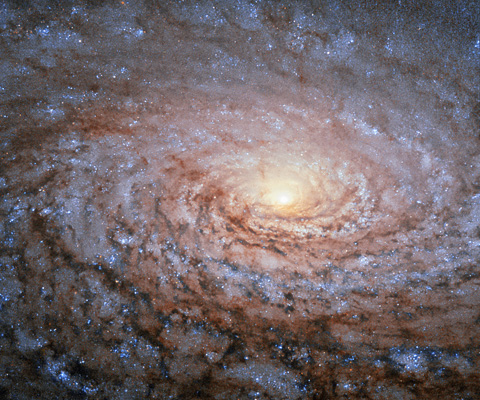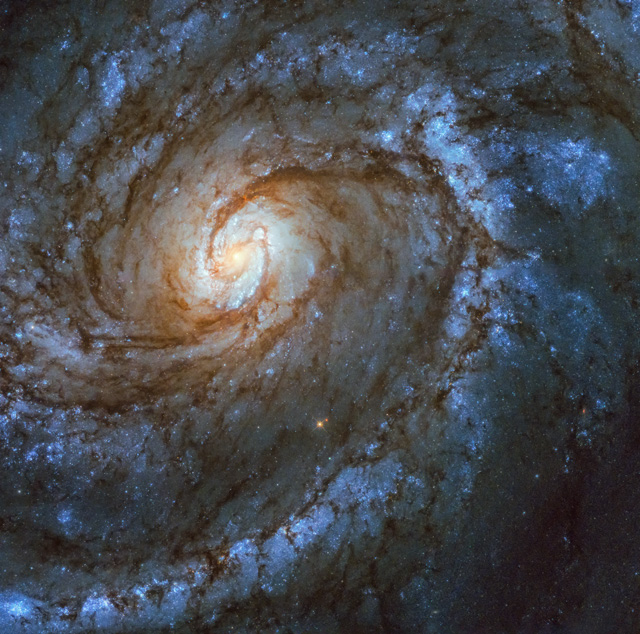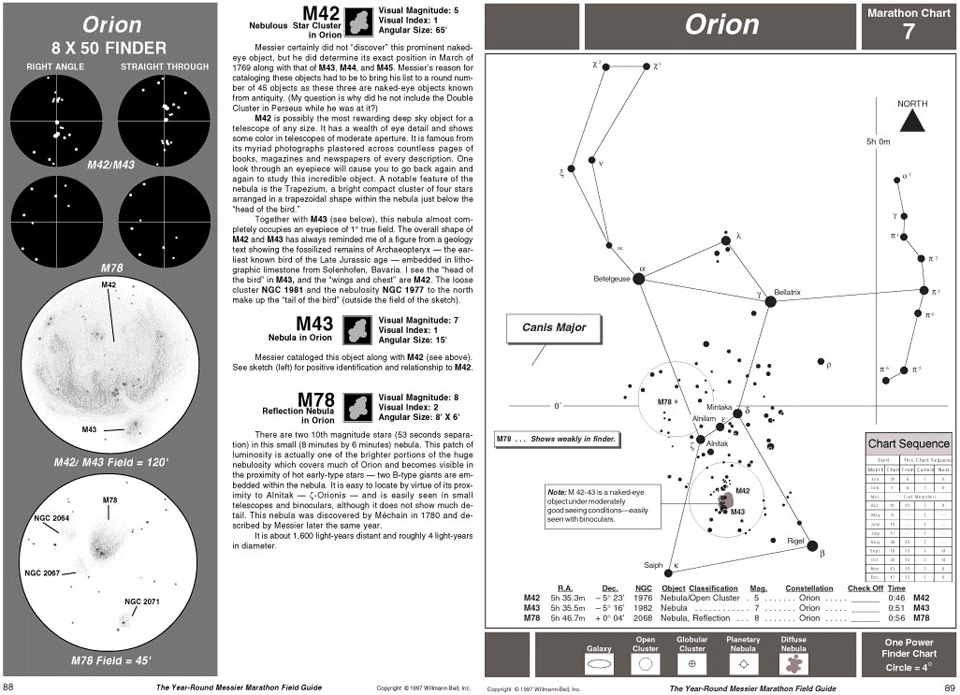Introduction
By no means complete, May’s mini guide that follows provides notes for exploring various interesting deep sky objects (DSOs) and lists other items of interest useful to the amateur astronomer.
Entries can be interpreted based on designation, description and magnitude as follows.
Designation – Description – Magnitude:
★ Telescopes 10-inch aperture minimum.
★★ Telescopes 6-inch to 9-inch aperture.
★★★ Binoculars (50mm+ aperture) and telescopes
3-inch to 5-inch aperture.
A collimated instrument, favourable atmospheric conditions, dark skies and dark-adapted eyes are assumed.

M63 spiral galaxy. Credit: ESA/Hubble & NASA.
About M63 spiral galaxy
The arrangement of the spiral arms in the galaxy Messier 63, seen here in a new image from the NASA/ESA Hubble Space Telescope, recall the pattern at the centre of a sunflower. So the nickname for this cosmic object — the Sunflower Galaxy — is no coincidence.
Discovered by Pierre Mechain in 1779, the galaxy later made it as the 63rd entry into fellow French astronomer Charles Messier’s famous catalogue, published in 1781. The two astronomers spotted the Sunflower Galaxy’s glow in the small, northern constellation Canes Venatici (the Hunting Dogs). We now know this galaxy is about 27 million light-years away and belongs to the M51 Group — a group of galaxies, named after its brightest member, Messier 51, another spiral-shaped galaxy dubbed the Whirlpool Galaxy.
Galactic arms, sunflowers and whirlpools are only a few examples of nature’s apparent preference for spirals. For galaxies like Messier 63 the winding arms shine bright because of the presence of recently formed, blue–white giant stars, readily seen in this Hubble image.
Credit: ESA/Hubble & NASA.
| May deep sky objects |
| Ursa Minor constellation |
|
NGC6217
|
A barred spiral galaxy that appears as an elongated blob with two spiral arms.
|
11.5
|
★
|
| Draco constellation |
|
NGC6643
|
Inclined spiral galaxy. A CCD camera is required to reveal its structure.
|
11.7
|
★★
|
| Serpens Caput constellation |
|
NGC5921
|
Galaxy with a faint periphery. A CCD camera is required to reveal its structure.
|
11.5
|
★★
|
|
NGC6027
|
Lies within a group of interacting galaxies being the brightest in the group.
|
14.2
|
★★
|
| Libra constellation |
|
NGC5897
|
Globular cluster with a low star density.
|
8.52
|
★★
|
|
M83
|
A near face-on spiral galaxy with a bright core that will resolve relatively well in moderate size instruments showing a degree of mottling. A large instrument is needed to observe its spiral arms, dark lanes and bright knots. Unfortunately, the M83 stays low in the sky.
|
8.50
|
★★
|
| Canes Venatici constellation |
|
M63
|
The Sunflower Galaxy is a barred spiral galaxy visible in binoculars where it appears as a patch of light. In moderate size instruments will reveal a star like core surrounded by a faint halo where large instruments would resolve some of its spiral structure under dark skies.
|
8.5
|
★★★
|
| Coma Berenices constellation |
|
M98
|
Nearly edge-on spiral galaxy. Appears as an elongated glow with a star like nucleus. Dark skies and larger instruments will start to reveal subtle detail.
|
11.0
|
★★
|
|
NGC4186
|
Faint galaxy located close to M98.
|
14.6
|
★
|
|
M100
|
Face-on spiral galaxy with a bright core and two main spiral arms. Its low surface brightness makes detail difficult to discern. In small instruments it will show a bright core and faint halo. Some mottling will be noticeable to 6 and 8-inch instruments. Large instruments under dark skies will hint the two prominent arms that become prominent in long exposures.
|
10.5
|
★★★
|
| Virgo constellation |
|
NGC5746
|
This barred spiral galaxy is visible 6-inch instruments, larger instruments will reveal the galaxy’s larger size.
|
10.1
|
★★
|
|
NGC4438
|
Along with its neighbour galaxy NGC4435 these two galaxies provide a great opportunity for CCD imaging.
|
10.8
|
★★
|
|
M84
|
A giant lenticular galaxy that appears as a hazy patch of light brightening towards its centre.
|
11.0
|
★★
|
|
M86
|
A lenticular galaxy that appears as a hazy patch of light brightening towards its centre. With the M84 are the two brightest galaxies in this rich region of space.
|
11.0
|
★★
|
|
NGC4762
|
Elongated galaxy that appears as a thin streak of light.
|
11.0
|
★★
|
|
NGC4754
|
Galaxy in the same field of view with the NGC4762. The two galaxies provide an excellent opportunity for CCD imaging.
|
10.5
|
★★
|
| Scorpius constellation |
|
M4
|
The Cat’s Eye is a bright 10 billion years old globular cluster close to Antares. An 8-inch instrument is required to start resolving individual groups of stars within the cluster.
|
7.5
|
★★★
|
|
M6
|
The Butterfly Cluster is a bright open cluster of 6th to 10th magnitude stars close to the centre of our Galaxy. It is visible to the unaided eye.
|
4.5
|
★★★
|
|
M7
|
Ptolemy’s Cluster is a bright open cluster of around 80 stars. Visible to the unaided eye it is better viewed at low magnifications.
|
3.3
|
★★★
|
|
M80
|
A small globular cluster with a bright core. Because of its dense centre high magnifications and larger apertures are needed to resolve fainter members.
|
8.5
|
★★
|
| Coma Berenices constellation |
|
M53
|
Globular cluster visible in binoculars as a faint glow. Higher magnifications will begin to resolve some of its members.
|
8.5
|
★★★
|
|
NGC5053
|
Loose globular cluster close to the M53.
|
9.47
|
★★
|
|
|
Designation, Description, Magnitude
|
★ Telescopes 10-inch aperture minimum.
★★ Telescopes 6-inch to 9-inch aperture.
★★★ Binoculars (50mm+ aperture) and telescopes 3-inch to 5-inch aperture.
|
The night sky
Under excellent conditions over 2,000 stars can be seen with the unaided eye but only a few hundred of these are prominent enough to be useful in navigating the night sky, these are normally included in amateur sky maps and digital planetarium programs like the SkySafari, Stellarium, The Sky, Starry Night, Winstars 2 etc. Some stars will show colour that is useful in identifying them. For example, Antares, Betelgeuse and Aldebaran are orange/red where Vega, Rigel and Spica appear as blue/white.
Stars that form easily recognisable patterns have been given names and are referred to as constellations. Of these, the brightest stars act as beacons and can be used to effectively navigate the night sky during the different months of the year. To that extent stars can be particularly useful in locating other interesting objects nearby normally viewable through binoculars or larger instruments.
Planets and their satellites, comets and meteors move independent of the night sky background and at comparatively high speeds. They are therefore very difficult or impossible to reference to any star. However, planets like Jupiter, Saturn, Venus and Mars as well as the Moon are easy to spot with the unaided eye and in the case of the larger planets and especially the Moon, even medium size binoculars will reveal a limited degree of detail.
M100 spiral galaxy
This stunning spiral galaxy is Messier 100 in the constellation Coma Berenices, captured here by the NASA/ESA Hubble Space Telescope — not for the first time. Among Hubble’s most striking images of Messier 100 are a pair taken just over a month apart, before and after Servicing Mission 1, which took place 25 years ago in December 1993.

M100 spiral galaxy. Credit: NASA, ESA.
After Hubble was launched, the astronomers and engineers operating the telescope found that the images it returned were fuzzy, as if it were out of focus. In fact, that was exactly what was happening. Hubble’s primary mirror functions like a satellite dish; its curved surface reflects all the light falling on it to a single focal point. However, the mirror suffered from a defect known as a spherical aberration, meaning that the light striking the edges of the mirror was not travelling to the same point as the light from the centre. The result was blurry, unfocused images.
To correct this fault, a team of seven astronauts undertook the first Servicing Mission in December 1993. They installed a device named COSTAR (Corrective Optics Space Telescope Axial Replacement) on Hubble, which took account of this flaw of the mirror and allowed the scientific instruments to correct the images they received. The difference between the photos taken of Messier 100 before and after shows the remarkable effect this had, and the dramatic increase in image quality.
COSTAR was in place on Hubble until Servicing Mission 4, by which time all the original instruments had been replaced. All subsequent instrumentation had corrective optics built in.
This new image of Messier 100 taken with Hubble’s Wide Field Camera 3 (WFC3), demonstrates how much better the latest generation of instruments is compared to the ones installed in Hubble after its launch and after Servicing Mission 1.
Credit: NASA, ESA.
Sky conditions
The prevailing sky conditions will have a significant effect on what you can see through any instrument and binoculars. As such if you live near a city the light pollution can make it difficult to locate and observe most DSOs. The Moon and a hazy sky will also have a negative effect.
For best results observe from a dark site and under clear transparent skies without the moon being present. Once your eyes have been accustomed to the dark conditions (this takes around 20-30 minutes) you should be able to enjoy the night sky at its best.
Filters
Filters will help to an extent and lager instruments will benefit more from them. Light pollution filters would help and photo-visual UHC (nebula filters) would be worth considering.
Printed aids
A huge number of printed aids exist in terms of deep sky maps and books. An excellent printed guide for people new in astronomy is The Year-Round Messier Marathon Field Guide published by Willmann Bell Inc.
In this large format hard-back book, the author, Harvard Pennington shows how to:
- Learn 17 bright finder stars and 17 prominent finder constellations so you will know where to look for all 110 Messier objects.
- Align a sighting device such as an 8x50 finder scope or the Telrad® so that you can point your instrument rapidly and with assurance toward all of the Messier objects.
- Calibrate your instrument so that you know exactly how much sky you see through your finder and through the eyepiece of your instrument.
- Find all of the Messier objects using the maps, drawings and descriptions in this book. You will know exactly where to point your instrument, and what the object should look like when you find it.

Extract from The Year-Round Messier Marathon Field Guide
published by Willmann Bell Inc.
Related topics:
night sky, deep sky object guide, May



